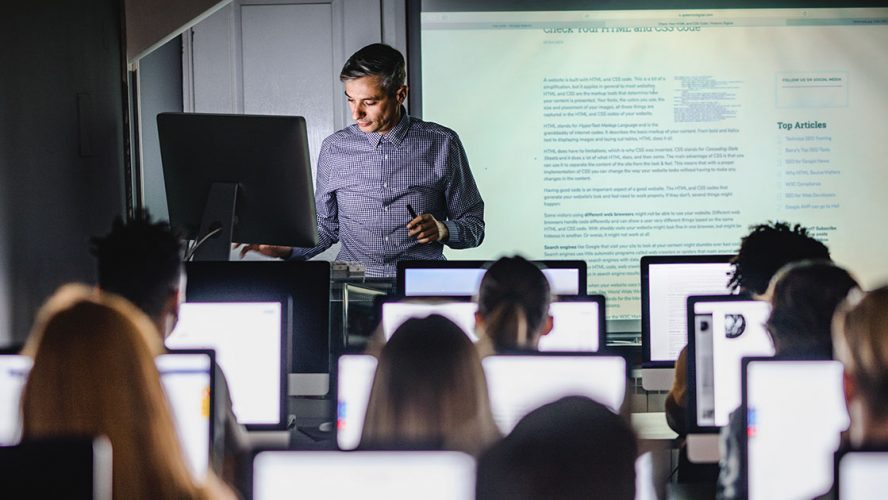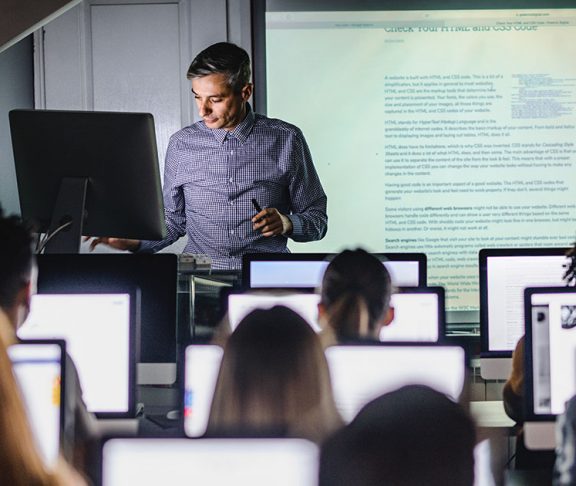The field of education is exploding with new technology that can empower students of all backgrounds to learn and help teachers make a greater impact.

Nidhi Tassone
Commercial Marketing Manager, Acer America
What will be your company’s main focus areas for education technology (ed-tech) in 2019?
We will continue to partner with schools in expansion of 1:1 student device programs and also focus on helping schools launch their Esports programs.
What will be your company’s main focus areas for education technology (ed-tech) in 2019?
Ed-tech-based curriculum can help model digital citizenship which is a critical skill for students to learn. Also, immersive technologies make student experiences like virtual college tours accessible for all students.
How can embracing modern ed-tech benefit educators?
Modern ed-tech creates opportunities for students to be collaborative and more engaged in the classroom.

John Copeland
Director of Education Sales for Barco USA
What will be your company’s main focus areas for education technology (ed-tech) in 2019?
Barco is focused on delivering end-to-end solutions for the education market that enhance teaching and learning experiences, both within and beyond the classroom. In 2019 we are focusing on helping students develop a rich set of skills, supporting teachers in the move from passive to interactive engagement and enabling IT to allocate resources and tools more efficiently.
We are focused on our full product portfolio, which includes wePresent which drives wireless interactive collaboration, weConnect active learning solutions, and our Remote Monitoring solution called Overture, which will improve the control of audio-visual equipment throughout the campus.
How can ed-tech make learning more inclusive and accessible?
Ed-tech has a key part to play in making learning more inclusive and accessible. Providing technology that allows students to share information on whatever device they have with them and then getting them interacting and collaborating on screen should be the norm, not the exception.
The use of online and distance learning can bring participants to the classroom from anywhere in the world and provide them with a collaborative learning environment.
How can embracing modern ed-tech benefit educators?
If educators are going to equip students with the skills they will need for the future, they need to get students to interact, collaborate and engage more than they have ever done before. Ed-tech allows educators to create a collaborative environment, driving more effective group collaboration and more engagement with course content.
Ed-tech also enables educators to offer their material in self-paced programs, or even foster competency-based programs. Ed-tech will increasingly be the primary method used to drive active learning in the classroom.
What advice do you have for educators looking to incorporate AI into their classroom and teaching style?
The first step is to recognize that the most important part of the classroom is the people: both the students and the teacher. Current application of technologies like AI and machine learning are being used to supplement or enhance what the educator is already doing. There is a lot of fantastic technology out there, but in the end the educator is paramount and they are not going to be replaced any time soon.
Ed-tech is developing quickly, and using this technology to produce advanced analytics and reporting can give the educator instant feedback on the effectiveness of their instruction. Educators need to be prepared to keep an eye on developments and be ready to adopt the technology that helps them deliver the learning experiences that students need for the 21st century.

Bethlam Forsa
CEO, Pearson K-12 Learning Services
What will be your company’s main focus areas for education technology (ed-tech) in 2019?
Our primary focus is on delivering one seamless learner experience within our Realize platform, enabling students to find all their content in one place. We are also keenly focused on giving teachers maximum flexibility to customize lessons to fit their students’ needs, and ensuring that Realize easily integrates with others like Google Classroom.
Another important area of focus for us is to give teachers maximum flexibility to customize content that fits their students’ needs. To support this, we are developing new learning experiences that feature expanded lesson customization. One example is our easy-to-use playlist feature that allows teachers to organize their lessons by building custom playlists for lessons just like they would for songs on their smartphone.
How can ed-tech make learning more inclusive and accessible?
Inclusivity starts with personalization. By personalization, I mean allowing the content and integrated formative assessment capabilities to be delivered at the right place and at the right time to make the most meaningful impact on the students’ learning outcomes. Students deserve a delivery mechanism that allows them to both demonstrate and authentically communicate their understanding.
Furthermore, we know that internet connectivity is not always available. As a result, we are always designing and thinking about use cases where content needs to be available offline. In fact, we have made it a priority to have our courseware and assessments work offline to ensure that when teachers and students need to access our content and data, they can do so knowing that they are supported either way.
How can embracing modern ed-tech benefit educators?
Embracing new technology means changing how we look at time spent in the classroom. If teachers can quickly pinpoint where and when students are advanced or challenged upfront, they have the opportunity to personalize instruction and remediation to support each learner individually.
Modern ed-tech has the potential to save countless hours of a teacher’s time customizing and organizing content, crunching data and assigning remediation. I hear from educators all the time that they want real-time data because it empowers them to make an immediate impact for their students based on timely insights.
We are passionate about ensuring that teachers have a modern technology platform that empowers them to easily prepare customized lessons designed for their own classrooms. When you empower educators with the right content, ed-tech tools and platform solutions, there really shouldn’t be any limits to the learning experience delivered to their students.
What advice do you have for educators looking to incorporate AI into their classroom and teaching style?
AI is built on data, so you must ensure you have a strong foundation of assessment data tied together using standards and scaffolded skills development. AI has tremendous potential to dynamically provide meaningful recommendations based upon student activity so teachers can make pointed adjustments with curated content to assist students moving forward.
AI is a tool to help teachers evaluate students. The teacher is the one that can truly deduce where and why students might be having performance issues and how to best intervene. I think it is about striking the right balance between AI-generated recommendations and dynamic adjustments with what your students need to achieve positive outcomes.

Silver McDonald
Head of LEGO Education North America
What will be your company’s main focus areas for education technology (ed-tech) in 2019?
With the most compelling and creative STEM learning solutions, LEGO® Education will continue its focus on delivering stimulating learning environments where students from pre-K all the way up to grade 12 are inspired and engaged through hands-on learning. We will also continue to support educators by providing the resources they need to bring playful learning to life for all students.
As learning can happen inside as well as outside of the classroom, our solutions also support creativity and develop confidence through after-school programs, robotics clubs, coding programs, makerspaces and competitions.
How can ed-tech make learning more inclusive and accessible?
Equity and access are core to our beliefs at LEGO Education. To be more inclusive, any given ed-tech solution needs to meet the children where they are on the learning curve and inspire a love of learning.
We want to make it easy for educators to incorporate us into the classroom. Our carefully curated system of robust hardware, software platforms and standards-aligned lessons are designed for students of all learning levels to flex their creativity, practice teamwork and expand social and emotional intelligence while developing their foundational knowledge and skills.
How can embracing modern ed-tech benefit educators?
Educators today face the challenge of fundamentally changing how they teach to keep up with an increasingly digital world and to keep their students motivated in learning. By embracing modern ed-tech solutions, educators can personalize learning to level the playing field for their students and keep them engaged by creating hands-on, active learning environments.
We know the importance of supporting teachers and administrators through this journey to truly impact learning, which is why we focus on providing professional development and lesson plans along with support in implementation and planning.

Charles Foley
Boxlight Advisory Board
What will be your company’s main focus areas for education technology (ed-tech) in 2019?
Building on Boxlight’s history of bringing interactive learning to the classroom, we’ll expand here to enable teachers to easily leverage richer content and structured learning into their environment. The Mimio MicroCloud technology vastly expands the content and resources available in the classroom, increasing the depth of the interactivity we’ve already enabled. Best-practice structured learning systems, rich digitized content and automated assessment tools provide a deeper learning experience while simultaneously reducing teacher workload. STEM and robotics are key areas of focus here, as we introduce tools, structured curriculum and associated content, making the learning more intuitive, engaging and effective for both students and teachers. Our MyBot Education platform allows students as young as kindergarten to learn about robots and coding without the traditional requirements of PCs or programming experience. They wirelessly connect to a robot from any smart device and begin to experience the adventure of robots from there.
How can ed-tech make learning more inclusive and accessible?
Educators now realize how different students benefit from different learning styles (visual, aural, physical, verbal etc.). Recently, this viewpoint has been expanded to include both social and solitary learning sub-types.
While traditional teaching tools are more aural in nature, today’s ed-tech is designed to allow the engagement of more senses in the learning process. This brings the potential for not only a richer learning experience for children who might have another preferred learning style, but also lays the foundation for collaborative learning, which enriches the experience for everyone in the process.
Having a selection of curated digitized content and resources right in the classroom to share with students lets teachers leverage the right resource to the needed learning style on a case-by-case basis, while including all students in the same learning cycle.
How can embracing modern ed-tech benefit educators?
The goal of most educators is to teach, so anything that enriches the experience for students helps drive this goal.
Today’s ed-tech can provide teachers anywhere in the world with easy access to best-practice curriculum and learning systems, richer digitized content that is curated and up to date at a moment’s notice and a more engaging teaching environment with a variety of audio, visual and tactile teaching aids. This combination of tools for the educator means that teachers can bring so much more to their students in the time allowed while reducing the burden of teachers on both administrative and prep work. The result is teaching that is easier, more enjoyable and engaging for both teachers and students.
What advice do you have for educators looking to incorporate AI into their classroom and teaching style?
Any teacher knows that each student is different, and by extension, each classroom dynamic is different. The ability to immediately know what works and what doesn’t can be key to an educator tailoring their methods, or their content, for a given group of students. The difficulty is getting that feedback without waiting to see and compare grades and progress until the end of a term. By leveraging AI, teachers can easily know how a given student or group is progressing, how a given subject is being received, and how well the educational experience is working.

